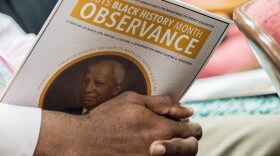Current students at Texas Tech University are only allowed to keep fish as pets while living on campus. But 50 years ago, some students brought animals that could eat like a cow. Literally.
The Texas Tech Dairy Barn used to serve as a hands on learning facility for students to gain experience and knowledge of the cattle industry. Now, it is a symbol for agriculture in West Texas.
According to Amy Mire, university archivist at the Southwest Collection Library, the dairy program allowed students to bring up to three cows to Texas Tech with them. The students could keep the cows in the dairy barn and use the profits from working and selling milk products to pay for their tuition. The work the students did in the barn paid for the cows keep.

Mire said the experience of working in the dairy barn was crucial to students’ success.
“This taught students how to care for their animals, how to manage a farm,” Mire said. “We had far more than just dairy cattle. There were horses, there were sheep, there were pigs. And all of it centered around the dairy barn. These students learned by doing.”
One alumnus who benefitted from the dairy barn was Jerome Beach. He lived and worked in the barn with eight other male students for two years, before he graduated in 1957. Beach said he enjoyed being in the barn.
“We worked three different shifts of milking and feeding the cows,” Beach said. “Everybody had a shift. And then we cooked our own meals. Everybody had a job to do, you know, cooking or washing dishes or cleaning up. And it worked real well.”
Beach said the daily operations went smoothly, since everyone was in a routine. Even the cows.

“I worked the night shift. When I started, I guess I did this the two years I was out there. I brought the cows into the barn and each one had a particular stall, and we’d put grain and protein out to them. The amount of milk they produced was how much grain they got to eat,” Beach said. “And every one of the cows would immediately go to their particular stall. And we’d take them from there and put them in a line going into the milking parlor, and two guys would be milking. There were three in each shift. Two milking, you know, and one feeding and bringing the cows into the barn.”
Beach said the money he earned while working there was used as spending money. He said he worked during the summer to pay for tuition. Although he did not make much, Beach said it was enough to get by.
“We were paid 60 cents an hour, we worked three hours each day. We made $1.80 a day. And we contributed one dollar a day for our food. Of course we had our milk, and we got eggs from the poultry division at the school,” Beach said. “We ended up doing real well just contributing a dollar a day.”
According to the Bureau of Labor Statistics, $1.80 would be $15.60 today, adjusting for inflation. Of course, tuition costs were around only $500 in the 1950s.
After graduation, Beach used the skills he learned at the Texas Tech Dairy Barn in his first job at a dairy in New Mexico. Beach went on to sell cotton and sorghum seeds to Lubbock area farmers for over 30 years. Beach said he could not think of a specific favorite memory, but he enjoyed the people he worked with in the barn.
Mire said alumni who worked in the barn tend to have a strong emotional connection to it.
“Some of our alumni who worked there,” Mire said, “they just look at the dairy barn and you can see all of the memories flash across their faces. It’s wonderful.”
Mire said students were not the only group to benefit from the dairy barn. The students would deliver dairy products such as butter and ice cream to Lubbockites around the city. Mire said in a time when people could not just run to the store for a bottle of milk, this service was important to the community.

The dairy barn was added to the national registry of historic places in 1992. In 2012, the barn got a new roof and a fresh coat of paint. As part of the current campus beautification project, trees are being planted around the barn in an area that was once grazing land for cattle.
Mire said she thinks the barn will remain a staple on the Tech campus for years to come.
“I think with the landscaping around it, it’s going to make it a very relaxing place to go and sit outside and study on beautiful days,” Mire said. “I think students are going to continue to enjoy it for many, many years”
The Southwest Collection Library is currently featuring an exhibit about the history of the Texas Tech Dairy Barn. The display features old milk bottles, ribbons from contests, and many pictures of the barn during operating years. The exhibit can be seen in the Coronelli Rotunda at the Southwest Collection Library and will run through the end of the month.





